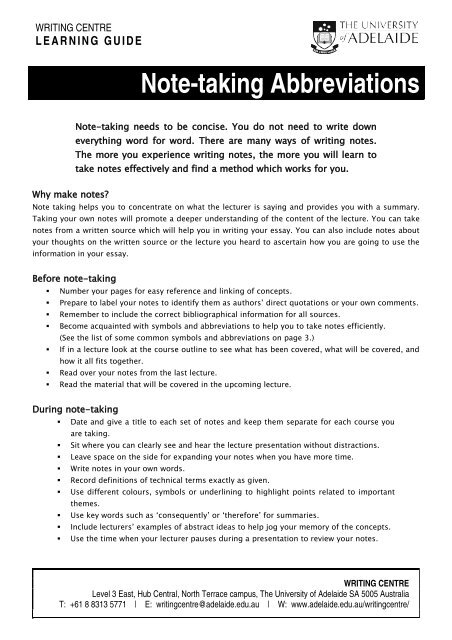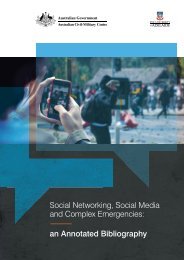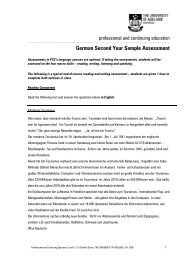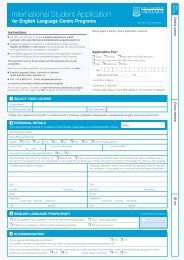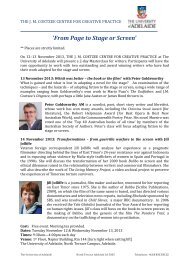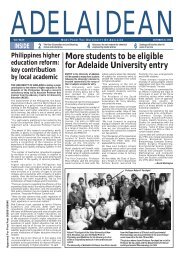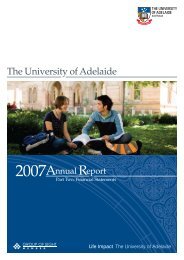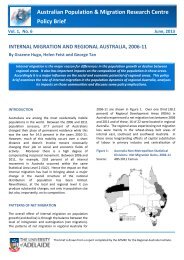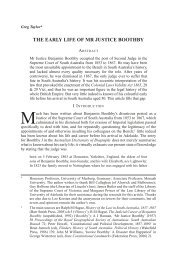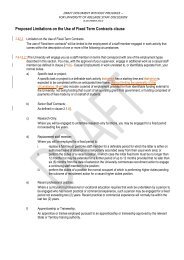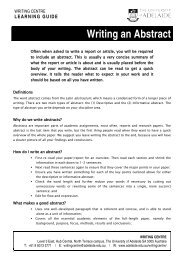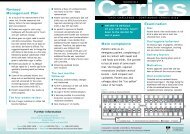Note-taking Abbreviations - University of Adelaide
Note-taking Abbreviations - University of Adelaide
Note-taking Abbreviations - University of Adelaide
You also want an ePaper? Increase the reach of your titles
YUMPU automatically turns print PDFs into web optimized ePapers that Google loves.
WRITING CENTRE<br />
LEARNING GUIDE<br />
Why make notes?<br />
<strong>Note</strong>-<strong>taking</strong> <strong>Abbreviations</strong><br />
<strong>Note</strong>-<strong>taking</strong> needs to be concise. You do not need to write down<br />
everything word for word. There are many ways <strong>of</strong> writing notes.<br />
The more you experience writing notes, the more you will learn to<br />
take notes effectively and find a method which works for you.<br />
<strong>Note</strong> <strong>taking</strong> helps you to concentrate on what the lecturer is saying and provides you with a summary.<br />
Taking your own notes will promote a deeper understanding <strong>of</strong> the content <strong>of</strong> the lecture. You can take<br />
notes from a written source which will help you in writing your essay. You can also include notes about<br />
your thoughts on the written source or the lecture you heard to ascertain how you are going to use the<br />
information in your essay.<br />
Before note-<strong>taking</strong><br />
Number your pages for easy reference and linking <strong>of</strong> concepts.<br />
Prepare to label your notes to identify them as authors’ direct quotations or your own comments.<br />
Remember to include the correct bibliographical information for all sources.<br />
Become acquainted with symbols and abbreviations to help you to take notes efficiently.<br />
(See the list <strong>of</strong> some common symbols and abbreviations on page 3.)<br />
If in a lecture look at the course outline to see what has been covered, what will be covered, and<br />
how it all fits together.<br />
Read over your notes from the last lecture.<br />
Read the material that will be covered in the upcoming lecture.<br />
During note-<strong>taking</strong><br />
Date and give a title to each set <strong>of</strong> notes and keep them separate for each course you<br />
are <strong>taking</strong>.<br />
Sit where you can clearly see and hear the lecture presentation without distractions.<br />
Leave space on the side for expanding your notes when you have more time.<br />
Write notes in your own words.<br />
Record definitions <strong>of</strong> technical terms exactly as given.<br />
Use different colours, symbols or underlining to highlight points related to important<br />
themes.<br />
Use key words such as ‘consequently’ or ‘therefore’ for summaries.<br />
Include lecturers’ examples <strong>of</strong> abstract ideas to help jog your memory <strong>of</strong> the concepts.<br />
Use the time when your lecturer pauses during a presentation to review your notes.<br />
WRITING CENTRE<br />
Level 3 East, Hub Central, North Terrace campus, The <strong>University</strong> <strong>of</strong> <strong>Adelaide</strong> SA 5005 Australia<br />
T: +61 8 8313 5771 | E: writingcentre@adelaide.edu.au | W: www.adelaide.edu.au/writingcentre/
After note-<strong>taking</strong><br />
Review and reflect on your notes soon after lectures to consolidate your understanding.<br />
Form questions on your notes to find the significance <strong>of</strong> the content and its application<br />
to other fields <strong>of</strong> knowledge.<br />
Highlight key points from your notes for exam preparation.<br />
Review and expand your notes by filling in the missing gaps, correcting errors, and<br />
making sure that you understand all abbreviations.<br />
Make a habit <strong>of</strong> carrying out short weekly reviews <strong>of</strong> your notes.<br />
Practise reciting the information using only keywords.<br />
Talk with other students about the lecture.<br />
Borrowing notes<br />
Borrowing notes should be a last resort. <strong>Note</strong>-<strong>taking</strong> differs between students because <strong>of</strong> interest,<br />
attentiveness and knowledge <strong>of</strong> the discipline area, as well as individual style and expression.<br />
If you must borrow notes then try to get more than one set.<br />
<strong>Abbreviations</strong><br />
When note <strong>taking</strong>, reduce the language by shortening words and sentences. If you are struggling to<br />
write down all the notes you want to take in a lecture, use abbreviations and symbols. Use only the<br />
abbreviations and symbols that fit your needs and that you will remember easily. It is better to introduce<br />
just a few abbreviations and symbols into your notes at a time.<br />
List <strong>of</strong> some common symbols and abbreviations<br />
∵ because<br />
+ OR & and OR plus<br />
?<br />
question OR doubt OR possibility<br />
> greater than<br />
< less than<br />
# OR no. number<br />
$ dollars OR money OR cost<br />
∆ change<br />
∴ Therefore OR consequently<br />
/ per OR each<br />
↑ increase OR mprovement<br />
→ leads to OR causes<br />
↓ decrease OR deterioration<br />
↔ linked OR interrelated OR connected<br />
↛<br />
does not lead to<br />
= equal OR the same as<br />
~ OR ≈ approximately OR around OR similar to<br />
≠ not equal OR not the same as<br />
2 Learning Guide © 2010 The <strong>University</strong> <strong>of</strong> <strong>Adelaide</strong>
X not<br />
∝ varies with OR related to<br />
… etc. OR missing words<br />
etc. etcetera; and the rest<br />
et al. and the other authors<br />
eg for example<br />
ie that is<br />
NB OR * note well OR remember this<br />
♂ / ♀ male / female<br />
§<br />
section<br />
OR para paragraph<br />
p. / pp. page / pages<br />
c<br />
w/o OR without<br />
with / about (circa)<br />
1 / 1 st / 2 etc. one / first / two etc.<br />
@ at<br />
2 to / too<br />
4 for<br />
cf. compare<br />
am morning<br />
pm afternoon<br />
viz namely<br />
asap as soon as possible<br />
Other helpful hints<br />
Make sure you understand your own symbols and actively look for and learn new ones.<br />
Develop a system to allow you to remember to come back and fill in the gaps, such as<br />
using a dash or space when you have missed a portion <strong>of</strong> what has been said.<br />
Develop or learn symbols which will help you identify important concepts referred to by<br />
the lecturer.<br />
Word truncation/contraction is another useful technique, e.g.<br />
ppl people<br />
res research<br />
hist / ling / comp sci / nursg / edn history / linguistics / computer science / nursing / education<br />
gov / lang / prog / pt / tchr government / language / program / patient / teacher<br />
Learning Guide © 2010 The <strong>University</strong> <strong>of</strong> <strong>Adelaide</strong> 3
Audio-taping lectures<br />
This should be a last resort if you cannot attend a lecture, and you must remember to ask for<br />
permission. Audio recordings are generally less informative, because they do not convey the entire<br />
lecture, i.e. visual cues. Remember that an audio-recording must still be listened to and this will take<br />
the same duration as the lecture itself. If you must use a recording, try to supplement this with notes<br />
from at least one other student.<br />
MyMedia Lecture Recording<br />
Lectures may be recorded and placed on MyUni by your course lecturer. These are another source to use<br />
to review your notes to ensure you understand the information.<br />
Useful resources<br />
Academic Learning and Language (ALL)<br />
ALL Semester Seminars include activity tasks for practice <strong>of</strong> an academic skill e.g. note-<strong>taking</strong>, and are<br />
delivered by expert lecturers in a relaxed environment. They are non-discipline specific, run for 50<br />
minutes in duration unless otherwise indicated, and no bookings are required. For more information,<br />
refer to: http://www.adelaide.edu.au/clpd/all/seminars/<br />
Websites<br />
http://www.bournemouth.ac.uk/study_support/note-<strong>taking</strong>.html<br />
http://www.dartmouth.edu/~acskills/success/notes.html<br />
http://istudy.psu.edu/FirstYearModules/<strong>Note</strong>Taking/Materials.htm<br />
Printables<br />
www.cs.sfu.ca/CC/AEP/pages/<strong>Note</strong>Taking.pdf<br />
www.dlsweb.rmit.edu.au/lsu/content/1_StudySkills/study_pdf/note<strong>taking</strong>_lecture.pdf<br />
www.sl.psu.edu/Documents/<strong>Note</strong>_Taking_Strategies.pdf<br />
If you require more assistance with <strong>Note</strong>-<strong>taking</strong> <strong>Abbreviations</strong>, please contact the Writing Centre on 8313 5771.<br />
Visit the Writing Centre website for additional resources: www.adelaide.edu.au/writingcentre/<br />
Principal Author: Donna Velliaris 2010, revised by Tahereh Pourshafie & Maureen Goldfinch December 2010<br />
4 Learning Guide © 2010 The <strong>University</strong> <strong>of</strong> <strong>Adelaide</strong>


